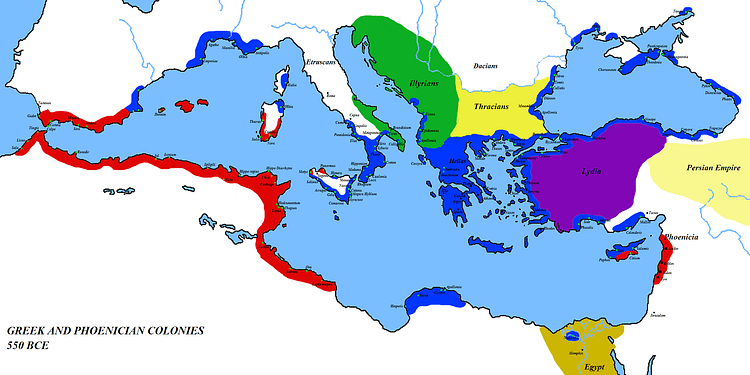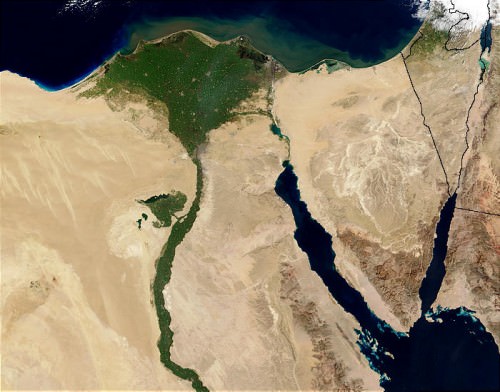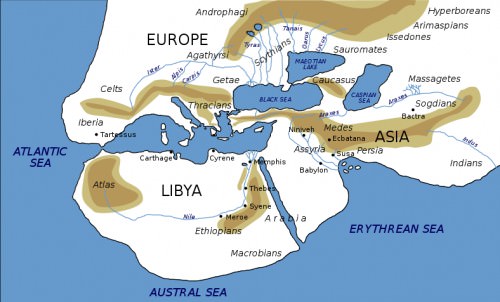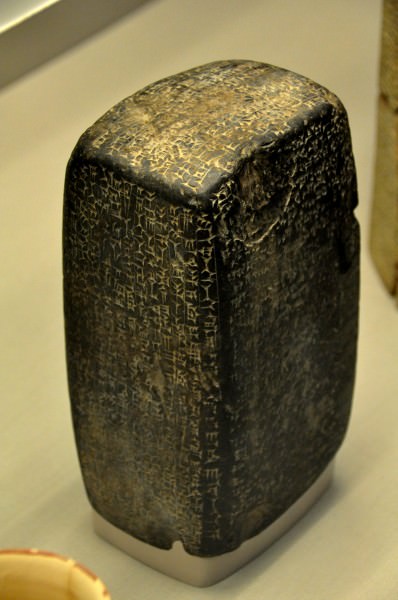Uat-Ur › Mitanni » Ancient origins
Articles and Definitions › Contents
- Uat-Ur › Antique Origins
- Mitanni › Antique Origins
Ancient civilizations › Historical and archaeological sites
Uat-Ur › Antique Origins
Definition and Origins

Uat-Ur was the ancient Egyptian name for the Mediterranean Sea (also known as Wadj-Wer ) and is translated as 'the Great Green'. Uat- Ur was the sea itself, not a god of the sea, but was sometimes pictured as a male with breasts heavy for nurturing and with skin resplendent with the shimmer of rolling waves. Uat-Ur is often shown in company with images of the Nile River, linking him sympathetically with the 'mother of all men' which was one of the titles the ancient Egyptians gave to the Nile.
EGYPT 'S INSULAR CULTURE
The Egyptians were not a great seafaring people. They were as interested in travel to foreign lands as they would have been in an earthquake. To the Egyptians, their land was a perfect world given by the gods, created from the primordial ben-ben upon which Atum first stood when dry land rose from the chaotic swirl of waters at the beginning of time.
Their god of chaos was Set (also known as Seth) who was associated with the lands beyond the boundaries of Egypt's Nile River Valley and who had as his consorts two foreign goddesses, Anat from Mesopotamia ( Syria ) and Astarte of Phoenicia. It was no coincidence that Set, who eventually came to be seen as the first murderer, was linked to the regions beyond Egypt's borders: the Egyptian culture was fairly xenophobic and distrusted foreigners and their influence.
Uat-Ur, therefore, did not feature prominently in Egyptian literary texts or religious writings. There are no great epics in Egyptian literature mentioning the "wine dark sea" as one finds in Homer of the Greeks. In the story of The Tale of the Shipwrecked Sailor (c. 2000 BCE) the main character is a servant, not a military hero, who is simply going about his master's business of trade when he is shipwrecked on the Island of Punt and meets the Lord of Punt, a gigantic serpent. The servant is not interested in any of the magical and glorious rewards one might find on Punt because he feels that anything he wants is back home in Egypt.
The Lord of Punt finally releases him to go home where he tells his master all that has befallen him. The Tale of the Shipwrecked Sailor perfectly epitomizes Egyptian cultural values as the main character is a common man aware of the concept of ma'at (harmony) and his duty to his social superior. When he reaches the Island of Punt he observes the same protocol he would back in his homeland with the significant difference of refusing to accept the Lord of Punt's offers of generosity. Whatever this foreign lord has to offer him, he knows, cannot compare with what he has left behind in Egypt.
THE TALE OF PRINCE SETNA
Another story, this one from the Ptolemaic Period (323-30 BCE), is The Tale of Prince Setna (also known as Setna I). Although there are many ways to interpret this story, and many lessons an ancient Egyptian audience would derive from it, one would have been not to involve one's self with strangers. In this story, Prince Setna sees an exotic woman named Taboubu and falls in love with her. He has never seen any woman as beautiful before in his life, lusts after her, and devotes himself to her completely after just meeting her.
Taboubu refuses his request to spend an hour with him in his hometown of Memphis and instead invites her back to her place in Bubastis. Even though Bubastis is an Egyptian city, it is still removed from Setna's home city of Memphis and he must take a boat to reach it. Once there, Taboubu makes requests of the prince which he grants instantly but she then asks for more and then more significant sacrifices on his part until, finally, he agrees to have his children murdered just to sleep with her. Before he can finally get her to bed, though, she vanishes and he finds himself naked in the streets of the foreign town. Only then is he told that his experience with Taboubu has all been a dream, his children are alive and well, and he thanks the gods for his good fortune.
STORIES LIKE THE 'TALE OF PRINCE SETNA' EXPRESS IMPORTANT CULTURAL VALUES IN THAT THE PRINCE IS WARNED BY THE GODS NOT TO BECOME INVOLVED WITH FOREIGN WOMEN.
This story, like The Tale of the Shipwrecked Sailor, expresses important cultural values in that Prince Setna is easily led astray by a woman he has never seen before. He is essentially warned by the gods through this dream-experience not to become involved with foreign women. The steady progression of Taboubu's requests from minor favors to capital crimes mirrors the Egyptian view of foreigners seeming to be innocent acquaintances at first but who eventually bring destruction.
POSSIBLE ORIGIN OF XENOPHOBIA
This fear of outsiders might be traced back to the latter part of the Predynastic Period in Egypt (c. 6000-c.3150 BCE) when outside influences began to affect Egyptian culture. During the period known as Naqada III (c.3200-3150 BCE) significant changes were set in motion in Egypt through trade with Mesopotamia. The construction techniques and technology used in creating the large tombs of Abydos and Hierakonopolis are Mesopotamian in origin and, as trade increased with regions of Palestine, new concepts and religious ideas were introduced. Increased trade with foreign lands led to the empowerment of some cities and the loss of prestige for others.
The power became concentrated in cities such as Naqada, Thinis, and Nekhen of Upper Egypt which then conquered Lower Egypt c. 3150 BCE resulting in the first king of a unified country, Narmer (also known as Menes ). This event could possibly have been traumatic enough for those of Lower Egypt to have produced a fear of the outside world which came to be expressed in stories, wisdom texts, and legends.

Nile Delta
However the original distaste for the outside world came about is actually immaterial, however, since the deep love the Egyptians had for their land caused them to feel there was no other region worth visiting. The reason why there is no Egyptian empire of the breadth of the Assyrian or Roman empires is not because they lacked military skill but because they did not want to travel that far beyond the borders of the country. The great military campaigns of Egyptian kings were all to neighboring regions such as Syria, Palestine, and Nubia. Although some kings of the New Kingdom (c.1570-1069 BCE) campaigned in Mesopotamia, this was unusual and they did not penetrate very deeply into the region.
The Egyptian belief in the afterlife as a perfect reflection of their time on earth led them to fear dying in a foreign land where they would have a harder time finding their way to the Field of Reeds than they would if they died in their own country. An important aspect of their culture was the mortuary rituals which needed to be performed precisely according to tradition in order for them to find peace in the afterlife. Egyptians who could afford it even paid high prices to be buried at Abydos, one of the god Osiris ' chief centers of worship, just so they could be nearer to him and have a better chance to reach the paradise promised by the religious texts.
UAT-UR AND THE OUTSIDE WORLD
This is not to say that the Egyptians did not engage in trade as they most certainly did. The Greek colony of Naucratis was extremely important to Egyptian and Greek commerce as was the more famous port of Alexandria close by. The Egyptians traded papyrus, linen, gold, leather, and grains for such goods as wood, marble, olive oil, copper, and wine. Beer was considered the drink of the gods in Egypt (as it was in Mesopotamia) and wine was a novelty. The cross-cultural exchange through trade was extremely important for both cultures but, in keeping with their traditional views, Egypt resisted cultural transference from Greece while Greeks readily adapted Egyptian views, religious beliefs, and technology.

World Map of Herodotus
Uat-Ur may not have played an important role in Egyptian beliefs but it was still personified as a living being. To the Egyptians, the whole world was alive with the spirit imbued by the gods and every tree or breeze, every place by a flowing stream, was a gift the gods had given and could also live in. The Mediterranean was not seen as simply a body of water but as a living entity with a personal name, Uat-Ur, because all of the world was alive with the spirit of creation to the ancient Egyptians. Even though they were not the great seafarers or explorers that the Greeks were, they still honored the sea with recognition and respect as another aspect of the world created and sustained by the gods.
Mitanni › Antique Origins
Definition and Origins

The Kingdom of Mittani, known to the people of the land, and the Assyrians, as Hanigalbat and to the Egyptians as Naharinand Metani, once stretched from present-day northern Iraq, down through Syria and into Turkey and was considered a great nation. Few records of the people themselves exist today but correspondence between kings of Mitanni and those of Assyriaand Egypt, as well as the world's oldest horse training manual, give evidence of a prosperous nation which thrived between 1500 and 1240 BCE. In the year 1350 BCE Mitanni was powerful enough to be included in the 'Great Powers Club' along with Egypt, the Kingdom of the Hatti, Babylonia and Assyria.
THE PEOPLE OF MITANNI
The Mitanni dynasty ruled over the northern Euphrates-Tigris region between c. 1475 BCE and c. 1275 BCE. While the Mitanni kings were Indo-Iranians, they used the language of the local people which was at that time a non Indo-Iranian language, Hurrian (and so the land is sometimes referred to in ancient records as the Land of the Hurrians ). The historian Leick writes, "The population of Mitanni was predominantly Hurrian, but the ruling elites were Indo-European warriors who called themselves Mariannu and who worshipped deities with Vedic names such as Indar, Uruwana, and the collective Devas. This elite was to intermarry with the local population, as the names of their children testify" (120). The capital of Mitanni was Wassukanni, located on the headwaters of the River Habur, a tributary of the Euphrates.
The name Washukanni is similar to the Kurdish word 'bashkani', 'bash' meaning good and 'kanî' meaning well or source, and so is translated as 'source of good' but also as 'source of wealth'. Some scholars have claimed that the ancient city of Sikan was built on the site of Washukanni, and that its ruins may be located under the mound of Tell el Fakhariya near Gozan in Syria.
The name Washukanni is similar to the Kurdish word 'bashkani', 'bash' meaning good and 'kanî' meaning well or source, and so is translated as 'source of good' but also as 'source of wealth'. Some scholars have claimed that the ancient city of Sikan was built on the site of Washukanni, and that its ruins may be located under the mound of Tell el Fakhariya near Gozan in Syria.
AT ITS HEIGHT, THE MITANNI DYNASTY CONTROLLED TRADE ROUTES DOWN THE HABUR TO MARI AND UP THE EUPHRATES FROM TO CARCHEMISH.
THE GREAT KINGDOM
At its height, the Mitanni Dynasty controlled trade routes down the Habur to Mari and up the Euphrates from to Carchemish.They also controlled the upper Tigris and its headwaters at Nineveh. Their allies included Kizuwatna in south eastern Anatolia, Mukish, which stretched between Ugarit and Quatna west of the Orontes to the sea, and the Niya which controlled the east bank of the Orontes from Alalah down through Aleppo, Ebla and Hama to Quatna and Kadesh. To the east the Mitanni had good relations with the Hurrian-speaking Kassites whose territory corresponds to present-day Kurdistan. The lands of the Mitanni in northern Syria bordered eastern Anatolia to its west and extended east as far as Nuzi (present-day Kirkuk) and the river Tigris in the east. In the south it extended from Aleppo across to Mari on the Euphrates in the East. The entire region allowed agriculture without artificial irrigation. Herds of cattle, sheep, horses and goats were raised and the Mitanni were famed horsemen and charioteers. It is recorded that they were the innovators who spearheaded the development of the light war chariot with wheels that used spokes rather than the solid wood wheels, such as those used by the Sumerians, so that the chariots were faster and easier to maneuver. Excavations of the Hittite archives of Hattusa, near present-day Boğazkale (Turkey), found the oldest surviving horse training manual in the world. The work was written in 1345 BCE on four tablets and contains 1080 lines by a Mitanni horse trainer named Kikkuli, beginning with the words, "Thus speaks Kikkuli, master horse trainer of the land of Mitanni” and exhaustively describes the proper methods of training horses.
KING TUSHRATTA & THE COMING OF THE HITTITES
Little is known of the early kings of Mitanni owing to the later destruction of the culture by the Assyrians but the names of the early rulers are known through the correspondences with other countries. In the 16th century BCE the most prominent kings seem to have been Kirta, Shuttarna, and Barratarna. King Shaushtatar (ruled c. 1430) extended the boundaries of Mitanni through the conquest of Alalakh, Nuzi, Assur, and Kizzuwatna. Egypt, under Tuthmosis III (1479-1425 BCE), defeated the Mitanni at Aleppo after a long period of contention over control of the region of Syria. Later Egyptian dynasties entered into pacts and treaties with Mitanni and the daughter of the Mitanni King Tushratta, the princess Taduhepa, was given in marriage to Amenhotep III (1391-1353 BCE) as part of a treaty which balanced power between the two nations.This treaty was put to the test during a power struggle in Washukanni between Tushratta and a relative of the previous king, Shuttarna, known as Artatama II. Egypt backed Tushratta in this conflict while the Hittite king Suppiluliuma I backed Artatama II. Tushratta seemed poised to succeed when Egypt, fearing the growing power of the Hittites, withdrew its support. Suppiluliuma I, tired of diplomacy and now free to do as he pleased without fear of Egyptian reprisal, led his forces on Washukanni and sacked it.Tushratta was assassinated by his son, perhaps in an effort to save the city. Following this conquest, Mitanni was ruled by Hittite kings.

Stone Foundation Document of King Adad-Nirari I
THE ASSYRIAN CONQUEST OF MITANNI
Suppiluliuma I divided the former kingdom into two provinces with their capitals at Aleppo and Carchemish. The remainder of the region kept some degree of autonomy, though still a vassal state, and was known as Hanigalbat. At some point the region which was once Mitanni fell under the yoke of the Assyrian Empire. Exactly when is not clear but possibly during the reign of the Hittite king Mursili II, (1321-1295 BCE) and definitely before the reign of Tudhaliya IV and the Battle of Nihriya in 1245 BCE (which marks the beginning of the decline of the Hittite Empire). The Assyrian king Adad-Nirari I (ruled 1307-1275 BCE) left inscriptions telling of how an upstart Hittite king Shattuara I challenged his might and so Adad-Nirari I marched on Mittani, crushed their forces in battle, and carried Shattuara I back to Ashur in chains where he was forced to swear an oath of allegiance to the Assyrian ruler. While still an autonomous state, the kingdom now owed tribute and allegiance to Assyria and was no longer considered an equal of the other powers of the region.
Ancient Assyrian records further tell how, in the reign of King Shalmaneser I (1270's-1240's BCE), King Shattuara II of Mitanni rebelled against Assyria with the aid of a nomadic tribe known as the Ahlamu around 1250 BCE. Shattuara's forces were well organized, fully armed, and had occupied all the mountain passes and waterholes to effectively cut off the Assyrian army's water supply and severely hamper their attempts at foraging. Even so, hungry and thirsty, Shalmaneser's army won a crushing victory. He claims in the records to have slain 14,400 men and the survivors were blinded and carried away. His inscriptions mention the conquest of nine fortified temples, 180 Hurrian cities were "turned into rubble mounds" and Shalmaneser "…slaughtered like sheep the armies of the Hittites and the Ahlamu his allies…". The cities from Taidu (also known as Taite) to Irridu were captured (an area which today comprises northern Iraq through Syria), as well as all of the region of the Mount Kashiyari range down to, and including, the city of Eluhat (also known as Eluhut which was located south-east in modern-day Turkey). A large part of the population of the conquered regions were sold into slavery and deported. Mitanni was then completely absorbed into the Assyrian Empire and gradually forgotten by history.
MAP
LICENSE:
Article based on information obtained from these sources:with permission from the Website Ancient History Encyclopedia
Content is available under License Creative Commons: Attribution-NonCommercial-ShareAlike 3.0 Unported. CC-BY-NC-SA License